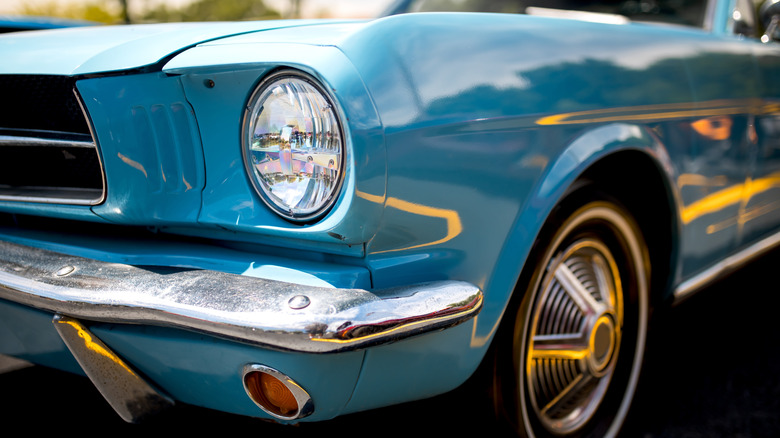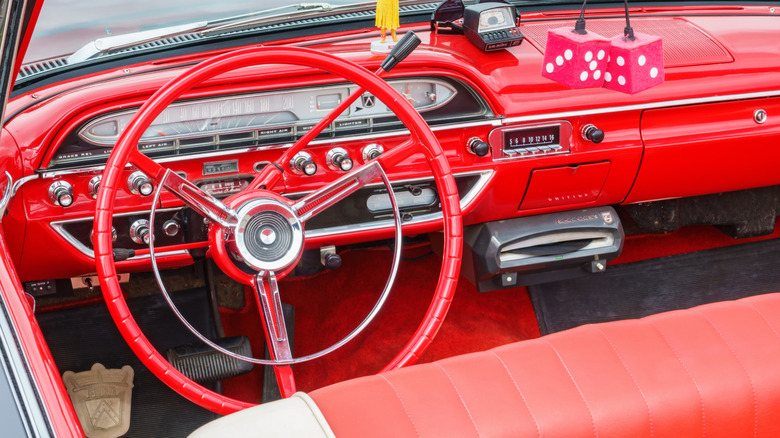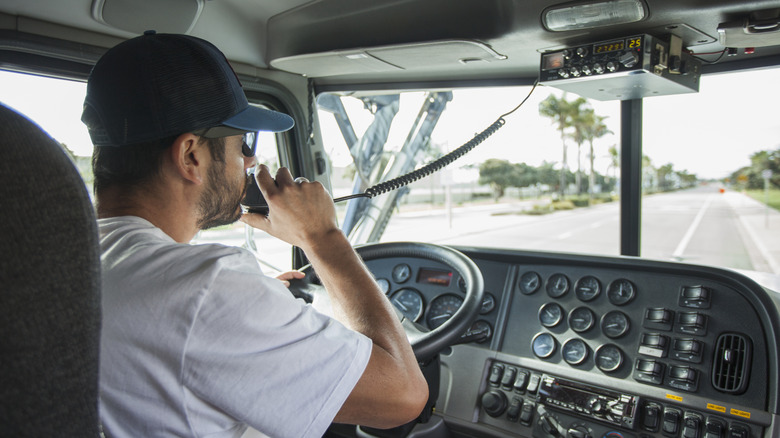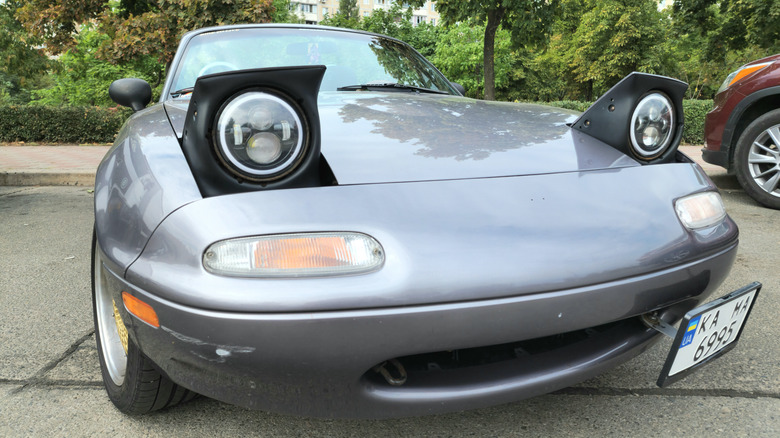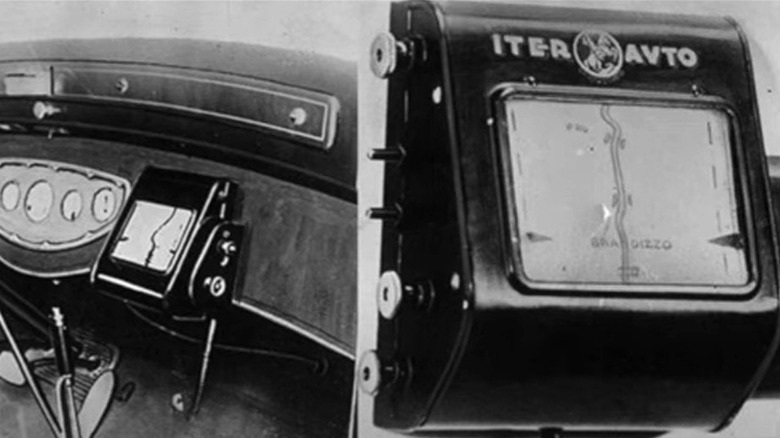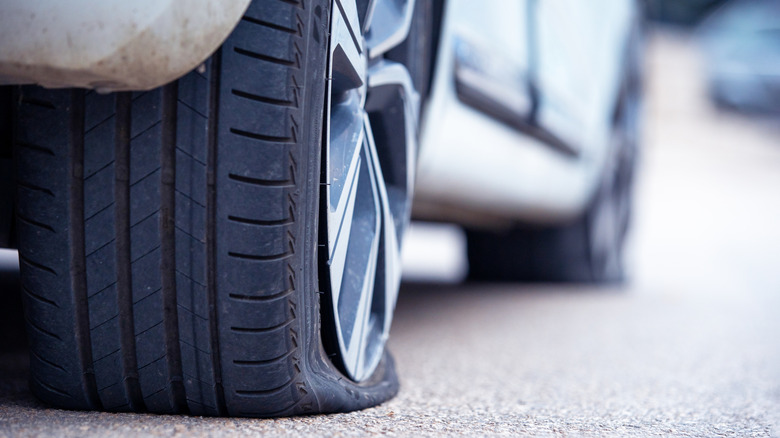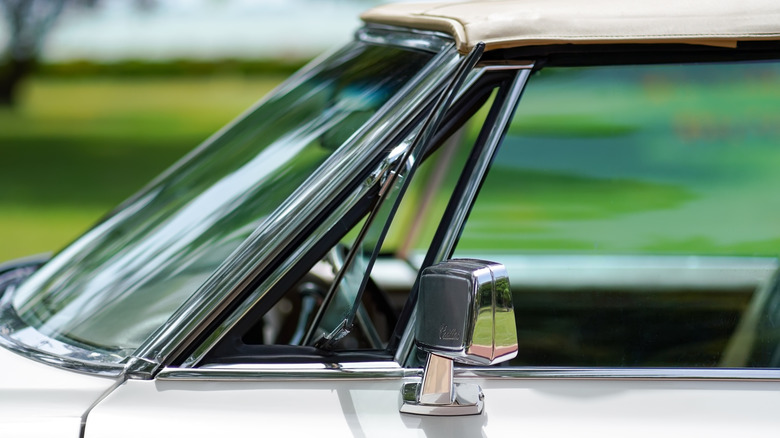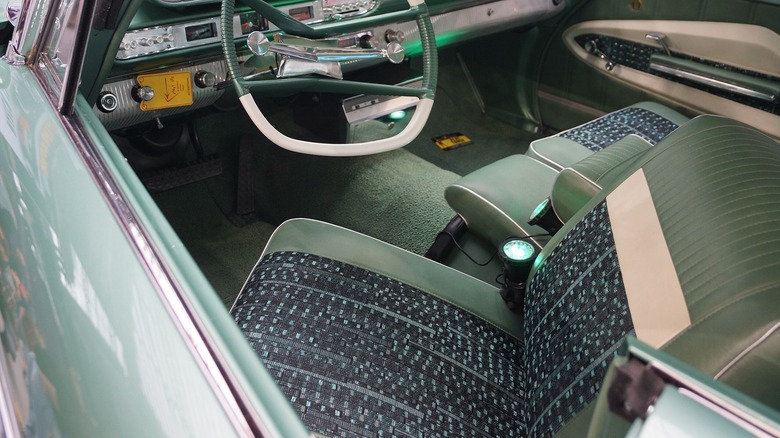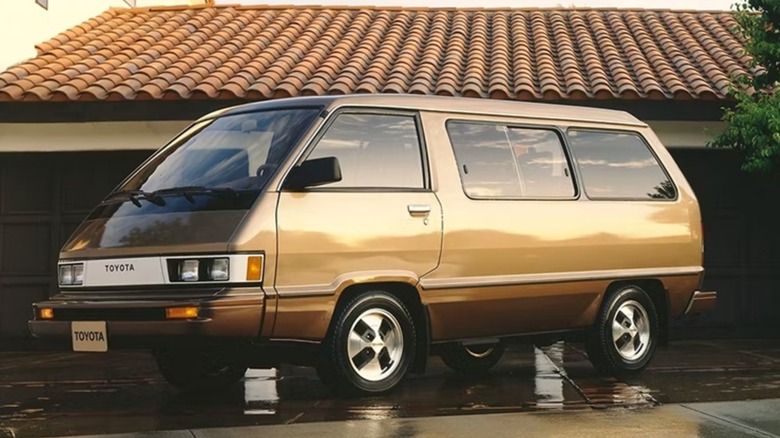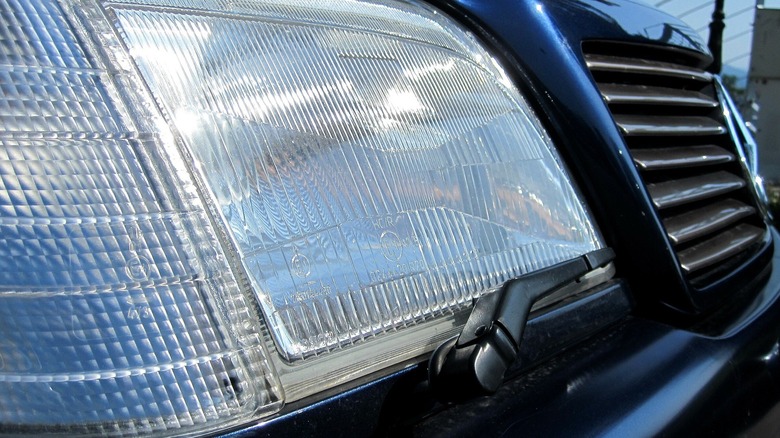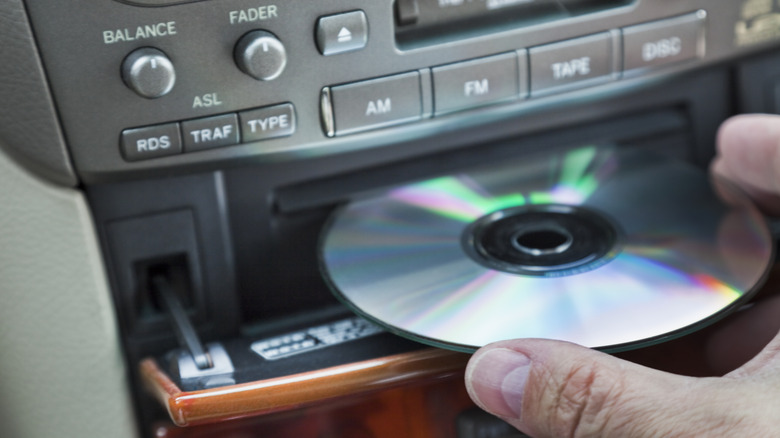11 Classic Car Features That We Miss In Modern Vehicles
Cars have changed quite a bit even in the last ten years, making features like rear view cameras and touch screen displays commonplace. Enjoy them while you can, though, because if history is any indicator, they'll soon be replaced by the next big thing.
The design of cars and the features they offer have changed consistently over time, in response to evolving roadways and drivers' changing behavior. Relatively smooth interstate highways allowed drivers to travel more quickly over long distances. Eventually, the separation of city centers and suburban living spaces meant people were spending more and more time in their cars. While cars were becoming ubiquitous they were also becoming more comfortable.
Over the last few decades, car manufacturers have invented a wide range of amenities to make your commute as comfortable as possible. Some of them attempted to anticipate or fill a need which didn't really exist or has since come and gone. Not all of these automotive features were good ideas, but they were inventive, they were emblematic of the time, and they made driving fun. For better or for worse, these are the bygone car features we miss the most.
Dashboard record player
Car culture was experiencing something of a heyday during the mid-twentieth century. Iconic motors were rolling off the factory floor and young people were spending more and more time behind the steering wheel, thanks in no small part to the advent of cruising. Of course, it's hard to have a fun or romantic evening out on the road without tunes, and if you wanted to listen to anything other than the radio bands in the '50s or '60s, you had to bring it from home.
These days, most folks use their cell phones to stream music, audiobooks, and podcasts on demand, but if you go back just a few decades, you'll find more primitive attempts to take music on the road. For a brief period in the '50s and '60s, motorists cruised with record players built into their dashboard. These luxury additions relied on custom-manufactured long-playing records and, predictably, they struggled with skipping while in motion. They soon gave way to more reliable 8-track tapes, followed by audio cassettes.
CB radios
In 1945, the Federal Communications Commission (FCC) created the Citizen Band (CB) radio service, opening a new line of communication for the masses. As with many technological innovations, early CB radios were expensive and took up a lot of space. Consequently, their use was reserved mostly for commercial operations who had the space and money to invest.
CB radios were particularly useful in places like mining operations where landline phones weren't readily available. They also became synonymous with long haul truck drivers. In fact, CB radios played a vital role in keeping trucks on the road during the 1973 oil embargo. As the technology evolved, CB radios shrank in size and price, making them more accessible to everyday drivers.
The technology peaked in the 1970s and '80s when CB radios offered a way for drivers to communicate with one another about road conditions, fuel availability, speed traps, and more. Sharing information over the airwaves, sometimes under the noses of authorities, led to the rise of anonymous radio handles and a unique set of slang, some of which like "10-4" remains in common use today. CB radios also provided a source of connection for lonely folks spending their lives on the open highway. CB radios were eventually pushed out by other communications technologies, most notably the cell phone.
Automatic seat belts
These days, seat belt use is commonplace, with more than 90% of drivers and passengers wearing them on the road. In the mid-twentieth century, however, seat belt usage was dismal. New legislation required that all auto manufacturers include some kind of automatic accident protection in their cars by the mid-'80s. For a moment, automatic seat belts were the answer to those regulations. They commonly worked by pulling a strap along the door frame from the windshield to the point between the front and rear doors. When the door closed, a strap automatically pulled itself diagonally from the waist to the shoulder.
The problem with this wasn't technological but cultural. Lap belts still had to be placed manually and most riders simply wouldn't use them. By the '90s, new legislation required the addition of airbags and automatic seat belts were phased out. Fortunately, the culture around seat belts changed and today most people wear them.
Pop-up headlights
In the '60s, '70s, and '80s, pop-up headlights were all the rage, but by the late '90s they were all but extinct. Pop-up headlights emerged as a compromise between necessity and beauty, providing light when you need it and hiding the headlights away when you don't.
Early headlights were big and bulky, and took away from the otherwise sleek design of midcentury and late twentieth century cars. Safety regulations required the use of sealed beam headlights which worked well enough but looked pretty dorky, especially when tacked onto the front of a narrow sports car. Pop-ups offered a solution by allowing manufacturers to meet federal regulations while still looking cool.
Any time you add moving parts, there's an extra opportunity for failure, and pop-up headlights were no exception. They had a tendency to break and get stuck in the open position. It wasn't the worst situation, you could still use your headlights, but it robbed you of the cool robotic motion that gave cars of that era so much character. Eventually, new lighting technologies emerged, federal regulations relaxed, and the pop-up headlight's popularity began to wane. They stuck around for a while in a few models, mainly sports cars, helping to cement their association with cool rides. Then they disappeared completely and cars got a little less cool.
Iter Avto automated map system
No matter which navigation service you use, they all rely on a network of satellites orbiting the planet. The United States operates a constellation of 31 GPS satellites while other constellations are operated by entities like the European Union and the Russian Federation. Collectively, they are known as the Global Navigation Satellite System and they provide data to Google Maps, Apple Maps, and everything in between.
GPS works by broadcasting signals which are received by your personal device. Those signals are time-coded to atomic clocks and, by calculating the precise time between when the signal was sent from the satellite and when it was received by the device, you can determine the distance between them. By determining the distance from multiple GPS satellites, you can figure out your position on the planet with an accuracy of less than 10 meters, which is good enough to get you from one place to another.
The Iter Avto device attempted to provide the same navigation service nearly 100 years ago, well before the space age. Drivers used map scrolls which rolled inside the device mounted in or near the dashboard. A cable attached to the speedometer ensured that the map scrolled at the same rate as the car, showing the driver's position in real time.
Spare tire
Everyone knows that when you get a flat tire, all you have to do is pop the trunk, grab a wrench and the spare tire, and swap it out. Fixing a flat is a common sight on highway roadsides, and having a spare used to be something you could count on. Today, many car manufacturers are ditching spare tires and potentially leaving drivers stranded.
According to a recent consumer report, only about 10% of new cars come with a full-size spare tire. Half come with a temporary tire, otherwise known as a space saver tire, and the rest come with a sealant kit if they come with anything at all. In recent years, manufacturers started removing spare tires as a way of reducing production costs, and of reducing the weight of the car to improve fuel economy and open up space in the trunk. The thinking goes that you rarely need the spare tire but it weighs a lot and takes up space all the time. Getting rid of it is a net benefit every day you're on the road, except for the day you get a flat tire.
If you're lucky, you've got a temporary tire capable of carrying you to a shop for a permanent fix. Typically, temporary tires should not be driven further than 50 miles or at speeds greater than 50 miles per hour. Alternatively, many cars now have run-flat tires capable of operating for short distances after suffering certain types of damage.
Vent windows
If you're feeling the heat while you're on the road, you've got a choice between cracking the window or turning on the AC. In the old days, you flipped open the vent windows. While today's car windows will let a breeze in, vent windows have the benefit of angling to put fresh air directly in your path.
Vent windows were small triangular windows mounted to a hinge and held in place with a small lock. They come from a time before automotive air conditioners and were used to help keep drivers and passengers cool on hot days. As cars evolved, air conditioning systems were introduced and drivers could more readily control the climate inside their cars. Vent windows were no longer needed.
There's also the problem of wind resistance. With the windows open, even comparatively small vent windows, wind resistance reduces fuel efficiency. Cars are more efficient with all of the windows closed, even if they're running the air conditioning. Getting rid of vent windows was better for our wallets and better for the planet. It was the right call, even if it's a bit of a bummer.
Rotating swivel seats
Today's car seats can slide backward, forward, and tilt at different angles to accommodate drivers of different shapes and sizes — but they are fixed on rails. Your chair faces forward and there's nothing you can do about it. In the past, some cars had rotating seats with the ability to turn toward the door or even turn all the way around.
Rotating seats, otherwise known as swivel seats, appeared in the 1960s. Chrysler introduced seats which rotated about 45 degrees, making it easier to get in and out of the car. For most people, sliding in and out of the driver's seat isn't a huge obstacle and swivel seats were solving a problem that didn't really exist. But they were very cool and that was the real point.
Some cars, like the 1961 Buick Flamingo featured a passenger seat which rotated a full 180 degrees, allowing passengers to more easily socialize when the car is stopped. Despite being cool, the comparatively complex construction of swivel seats meant they could fail more easily and they were less safe than modern seats. As safety regulations evolved and the needs of modern drivers changed, the swivel chair's popularity faded.
Ice maker
The first known use of the term "soccer mom" dates back to 1982, around the same time that minivans were first hitting the road. At around the same time, Toyota was trying to establish a foothold in the United States with, among other vehicles, the simply named Toyota Van. With other vans from more recognizable manufacturers, Toyota had to do something to stand out. The Toyota Van was spacious, had an innovative design, and offered a pretty cool (pun intended) feature to entice wary American drivers.
The Van featured an unconventional engine layout which positioned the engine compartment beneath the driver's seat. If you needed to check the oil level or do routine maintenance, you'd lift up the seat instead of popping the hood. That unusual setup should have been a clue that the Toyota Van wasn't a conventional vehicle.
Between 1984 and 1989, the Toyota Van (known as the Space Cruiser in Europe) offered an optional ice maker. The cooler box came with spillproof ice trays and the whole thing was cooled using the vehicle's air conditioning refrigerant lines. As long as you kept the trays filled, you'd always have fresh ice to keep your drinks cold during soccer practice.
Headlight wipers
Headlights are an important safety feature whenever you're driving at night or in poor weather, but they can only work correctly if they're free of obstructions. To that end, during the 1980s and '90s, some cars featured tiny wipers to keep the headlights clear. They worked just like your windshield wipers, only smaller, to clear away obstructions.
Saab introduced headlight wipers and other manufacturers soon adopted them. Like many features on this list, they were initially common in luxury cars. Which is funny because they are less likely to drive through the mud and muck, making headlight wipers more of a status symbol than a useful tool.
They became increasingly popular throughout the '90s but they never quite lived up to their own hype. Because of their position at the very front of the vehicle and low to the ground, they were prone to damage and did not hold up to wear and tear as well as windshield wipers. While they could be useful for clearing away mud or snow buildup, the wipers were not particularly useful during an active rain storm. Ultimately, as headlight technologies improved, it became less important to keep the headlights clear and headlight wipers disappeared.
CD changer
The first commercial car radio was produced by Motorola and introduced in 1930. By the early '50s, FM radio had reached the automobile and a few years later the in-car record player brought the first on-demand music to the road.
A few iterations later, after the 8-track and the cassette tape, the world was introduced to the compact disc in the early '80s. For the first time, people could shuffle songs, skip tracks, and they never had to rewind. CDs changed the music game by allowing people to take their music collections with them and switch through albums with relative ease.
For a while, the CD player was cutting edge and people carried folders with dozens or hundreds of albums. Disc holders attached to the visors were commonplace, keeping your favorite albums within arms reach while you were driving. If you were lucky, you had a built-in CD changer which made things even easier. CD changers could hold several albums (usually six but sometimes more) and you could jump from one to another with the press of a button.
